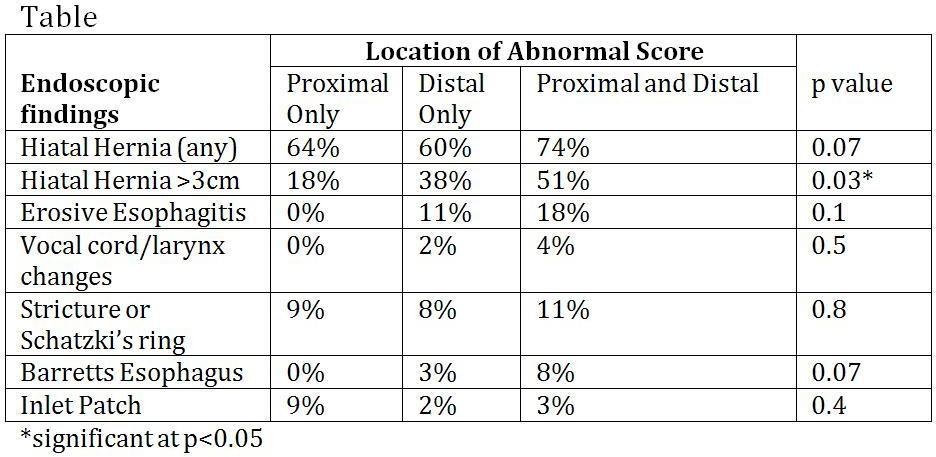|
Back to Annual Meeting Program
Dual Probe pH Monitoring Is Not Useful in Patients With Reflux Disease and Respiratory Symptoms
Stephanie G. Worrell*, Steven R. Demeester, Evan T. Alicuben, Christina L. Greene, Daniel S. OH, Jeffrey a. Hagen
Keck School of Medicine of Univeristy of Southern California, Los Angeles, CA
Introduction: The etiology of respiratory symptoms such as cough, hoarseness, and asthma is often multi-factorial. Gastroesophageal reflux can cause or contribute to these symptoms. Typically pH monitoring is done to identify patients in whom reflux may be related to respiratory symptoms. A dual probe study has been recommended for these patients based on prior studies showing that approximately 17% will have abnormal acid exposure only at the proximal probe. The aim of this study was to determine the frequency of isolated abnormal proximal acid exposure, and to evaluate symptoms and endoscopic findings associated with distal versus proximal acid reflux.
Methods: We reviewed the records of all patients that had dual probe pH testing from January 1999 to November 2012. Only patients with complete foregut evaluation including endoscopy, video esophagram, and motility were included. Increased esophageal acid exposure was defined as a DeMeester composite score of >14.76 in the distal probe and >16.4 in the proximal probe. Dual probe pH catheters with sensors spaced 10, 15 or 18 cm apart were selected such that the proximal probe would be as close as possible to the upper esophageal sphincter in each patient.
Results: From 425 total patients 256 (60%) had increased esophageal acid exposure on dual probe pH testing. Presenting symptoms in these patients were heartburn (73%), regurgitation (60%), cough (54%), hoarseness (50%), or asthma (24%). The location of abnormal reflux was at the distal probe only in 133 patients (31%), at the proximal probe only in 11 patients (3%) and at both probes in 112 patients (26%). There was no significant difference in the prevalence of cough, hoarseness or asthma based on location of the abnormal acid exposure. Abnormal acid exposure at both the proximal and distal probes was most likely to occur in patients with a hiatal hernia larger than 3 cm in size [Table].
Conclusions: Patients with increased esophageal acid exposure at both the proximal and distal probes tended to have more severe reflux disease with hernias larger than 3 cm in size, erosive esophagitis and Barrett's esophagus. Isolated abnormal proximal acid exposure was uncommon, and was not associated with different symptoms. These findings suggest that dual probe pH monitoring does not significantly improve the ability to detect patients with reflux disease that might be related to respiratory symptoms compared to standard pH monitoring in the distal esophagus. Consequently, there is little added benefit to monitor patients with a dual probe pH system.

Back to Annual Meeting Program
|


